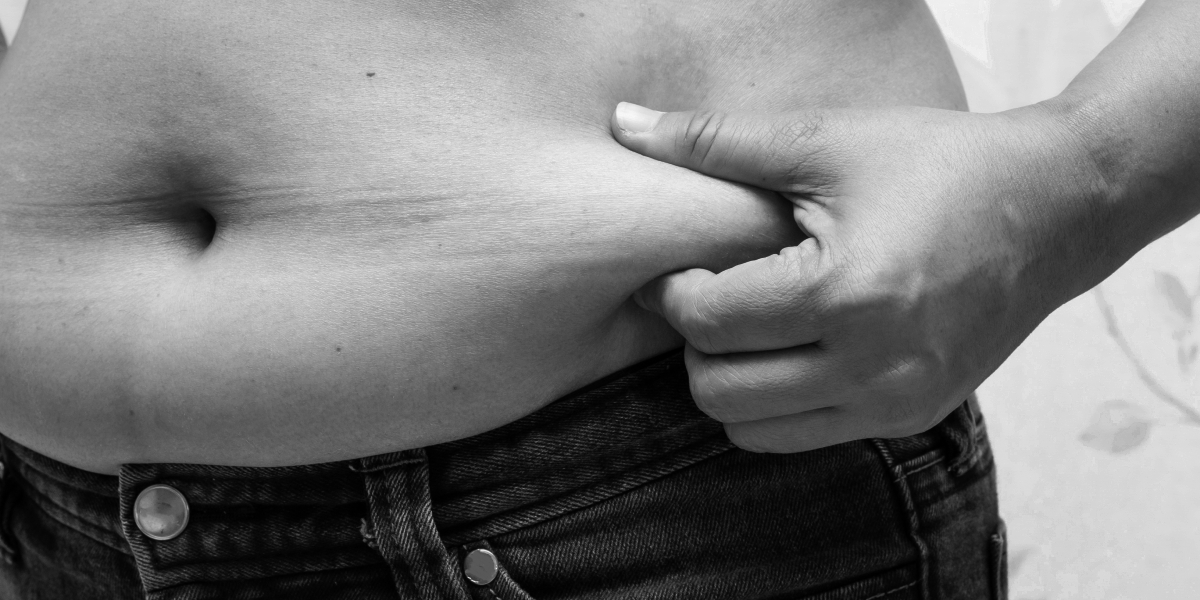Rising rates of abdominal obesity pose a significant health risk in Kerala and Tamil Nadu. Women are more abdominally obese than men.

Research reveales that being overweight or obese heightens the risk of ED by 30-100 percent. (Creative Commons)
Abdominal obesity, also referred to as central obesity or visceral obesity, is a concerning health issue prevalent in the states of Kerala and Tamil Nadu. In these regions, approximately three in five women, and over one in five men are affected by abdominal obesity.
Abdominal obesity is characterised by the excessive accumulation of fat in the waist and abdomen, leading to an increased risk of metabolic disorders and various diseases. While it is normal to have some amount of fat in the abdominal region for essential bodily functions, an excessive build-up of fat in this area can have detrimental effects on health.
The prevalence of abdominal obesity is particularly significant in Kerala, where 65.7 percent of women are affected, representing the highest rate in the country. Similarly, in Tamil Nadu, 58.3 percent of women have abdominal obesity, which is also among the highest in the country.
Among men, 23.5 percent in Kerala and 28.7 percent in Tamil Nadu are impacted by abdominal obesity, again reflecting the highest rates nationwide.
These facts are according to a recent study published in the Lancet, based on the fifth National Family Health Survey (NHFS-5).

Abdominal obesity has the highest incidence in Kerala and Tamil Nadu in South India. (Wikimedia Commons)
In the country as a whole, the prevalence of abdominal obesity is notable. Around 40 percent of women and 12 percent of men are affected by abdominal obesity. However, when looking at gender and specific age groups, the numbers become even more concerning.
Among women aged 30-39 years, 49.3 percent cross the cut-off mark for abdominal obesity. This increases to 56.7 percent in women aged 40-49 years.
“India did not experience high rates of abdominal obesity or elevated BMI before. Due to widespread malnutrition and food scarcity, our population faced significant nutritional deficiencies, particularly among women,” Dr Vidya Tickoo, a consultant endocrinologist and diabetologist at the Hyderabad-based Yashoda Hospital, tells South First.
“Over time, as resources improved, access to food increased. However, genetically, our bodies were adapted to functioning with limited food intake. As we started consuming larger quantities of food, our bodies were unable to efficiently store excessive amounts of fat. The shift towards a diet rich in high-fat, processed foods has contributed to fat accumulation, with the abdomen being a common area for storage,” she adds.
Interestingly, when considering BMI measurements, only 23 percent of women exceed the cut-off mark for obesity. This indicates that some women who have a healthy BMI can still have abdominal obesity, emphasising the importance of evaluating abdominal fat distribution separately.
Body Mass Index (BMI) is a numerical value calculated from a person’s weight and height, and is commonly used as a screening tool to assess whether an individual’s weight falls within a healthy range. It is a convenient tool that could be used to assess obesity.
However, abdominal obesity has come to the fore to determine a better way of healthy living. Abdominal obesity determines excess fat accumulation around the waist and abdomen, and is often highlighted as a significant health concern because it is associated with increased health risks — even independent of BMI.
BMI is calculated as the weight (measured in kg) divided by the square of the height (measured in metres). A BMI between 25 and 29.9 is considered overweight, while a BMI above 30 is considered obese.
Abdominal obesity can vary across different ethnic groups and genders. Individuals of South Asian descent may be at a higher risk of health problems related to abdominal obesity, even at lower BMI values.
“The BMI may not always be the most accurate criterion for identifying obesity in individuals. There is a popular anecdote highlighting this issue, where an Indian doctor and a Caucasian doctor measured their BMI and obtained the same result, indicating that they were not obese. However, further examination revealed that the Indian doctor had a higher amount of abdominal fat compared to the Caucasian individual, indicating a difference in body composition,” explains Dr Tickoo.
“This emphasises the limitations of BMI as the sole indicator of obesity and the importance of considering other factors, such as abdominal fat distribution,” she adds.
In 1997, the WHO acknowledged the significance of abdominal obesity and proposed using indicators such as waist circumference to identify populations at a higher risk of abdominal obesity.
Abdominal or central obesity is defined as having a waist circumference of more than 80 cm in women and more than 94 cm in men. It is a strong predictor of cardiovascular diseases, type 2 diabetes, and other metabolic disorders.
Abdominal obesity is often associated with an apple-shaped body appearance, where fat is predominantly distributed around the waistline. This type of fat accumulation is known as visceral fat (also called intra-abdominal fat), which surrounds internal organs such as the liver, pancreas, and intestines.
Unlike subcutaneous fat (fat located just beneath the skin), visceral fat is metabolically active and can release hormones and chemicals that contribute to various health conditions.
“Excessive abdominal fat has been linked to an increased risk of heart disease, high blood pressure, and stroke. Visceral fat can release inflammatory substances that can affect blood vessels and lead to arterial damage and atherosclerosis,” explains Dr Tickoo.
She adds that abdominal obesity is associated with insulin resistance, which could lead to an increased risk of developing type 2 diabetes. “The release of inflammatory substances from visceral fat can interfere with insulin release and glucose regulation,” says Dr Tickoo.
A Lancet study indicates that women tend to be more abdominally obese than men.
“Obesity is primarily a result of inadequate physical activity and an imbalance between calorie intake and expenditure. When individuals consume more calories than they burn, especially coupled with a lack of physical activity, it can lead to an increase in abdominal fat,” ICMR-National Institute of Nutrition’s Director Dr R Hemalatha tells South First.
Dr Hemalatha adds that this issue is more prevalent in women, partly due to hormonal factors and a tendency for women to store more fat.
“The differential fat deposition between men and women exacerbates the problem when combined with a lack of physical activity and higher calorie consumption,” she explains.
The rural economy in India is currently undergoing an economic transition, leading to a significant decrease in the female workforce’s involvement in economic activities. This shift might also indicate a decrease in physical activity levels among women, particularly in rural areas.
A recent study conducted in India revealed that nearly three in five people in India (57 percent) were either physically inactive or only mildly active, with females exhibiting lower levels of physical activity compared to males.
Studies have shown that men and women differ in the patterns of fat deposition and fat utilisation by the body. Women generally have a larger proportion of body fat mass as compared to men.
Oestrogen has an effective role in the distribution of fat deposition in women. It plays a protective role in preventing the deposition of abdominal fat in women of reproductive age.
“However, after menopause, women experience a decline in oestrogen levels, which is independent of the natural ageing process. This loss of oestrogen makes women more susceptible to abdominal obesity. Without the beneficial effects of oestrogen, the distribution of fat in the body can change, leading to a higher tendency for fat accumulation in the abdominal region,” explains Dr Tickoo.
She adds that women tend to have a lower metabolic rate while engaging in sedentary activities, which means they burn fewer calories during periods of inactivity. This lower metabolic rate contributes to a higher likelihood of fat accumulation in the abdominal region, leading to increased abdominal obesity.
Obesity arises when there is an imbalance between the energy consumed through food intake and the energy expended through physical activity. To prevent the accumulation of excess fat in the body, it was important to maintain a balance between these two factors. Engaging in regular physical activities helps to utilise surplus energy effectively.
According to a study, physical inactivity rates reach as high as 72 percent in South India. This higher prevalence of physical inactivity in the south makes the region more susceptible to obesity and, subsequently, increases the risk of chronic diseases.
According to a study on dietary patterns in India, processed foods contribute to approximately 10 percent of the average total caloric intake. Urban households in the highest income group are at the forefront of this nutrition transition, obtaining nearly 30 percent of their daily calories from processed foods. Among different regions of India, South India has the highest share of calories derived from processed foods.
In a previous interaction, India’s leading diabetologist Dr V Mohan, Chairman of Dr Mohan’s Diabetes Specialties Centre and Madras Research Foundation, told South First that those with job opportunities in other countries and a change in occupation — non-agriculture jobs — also saw an increase in income.
Those who would once walk for kilometres to work in the field now use motorised transport and trucks to plough the field, and so on, leading to a sedentary lifestyle.
This reduced physical activity and the availability of technology have led to a lack of exercise. This coupled with poor eating habits has increased the risk of diabetes.
According to the Lancet study, the prevalence of abdominal obesity is higher among urban residents compared to rural residents, for both men and women. There appears to be a higher prevalence of abdominal obesity among wealthier sections of the Indian population.
Obesity is often associated with urban and wealthier populations, but the NFHS-5 data revealed distinct obesity patterns in urban and rural areas of India. Changes in the rural economy and proximity to urban centres contribute to this divergence.
As agriculture decreases and non-farm activities rise, rural residents encounter new economic opportunities, potentially altering their dietary choices towards processed foods high in calories but low in nutrients.
Notably, approximately one-third of rural women aged 15-49 are abdominally obese.
Proximity to urban centres also influences rural obesity, affecting access to economic opportunities and processed food supply chains.
The study says that the economic status of households plays a significant role in the prevalence of abdominal obesity in India. This aligns with the findings of previous studies that observed a higher occurrence of overweight/obesity among individuals with a high standard of living.
Additionally, the consumption of a diet rich in fats contributes to the higher prevalence of abdominal obesity among wealthier sections. Research indicates that higher-income groups derive 32 percent of their energy from fat, whereas lower-income groups derive only 17 percent of their energy from fat.
The study also finds that as India undergoes economic development, it is also experiencing a nutrition transition characterised by changes in dietary patterns. This transition includes the substitution of brown rice with white rice, overconsumption of refined and processed foods, a diet high in carbohydrates, and increased consumption of vegetable oil.

Jul 26, 2024

Jul 26, 2024

Jul 26, 2024

Jul 26, 2024

Jul 26, 2024

Jul 26, 2024